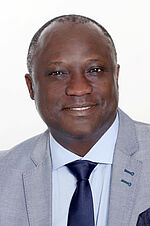
Director of the Institute for Stem Cell Research and Regenerative Medicine (ISRM)
Heinrich-Heine-University
Moorenstraße 5
40225 Düsseldorf
Research Interest
My research encompasses systems biology-based projects both at the national and international level where iPS cells (induced pluripotent stem cells) are used to model human brain –associated diseases; Alzheimer’s and Nijmegen Breakage Syndrome.
Specific Projects
Late Onset Alzheimer’s Disease
I was workpackage leader in the FP7-funded (01.01.2013-31.12.2017) project- AgedBrainSYSBIO (EU/FP7- HEALTH-2012.2.2.2-1).
The consortium combined integrative systems biology and comparative genomics for studying sporadic Late Onset Alzheimer’s Disease (LOAD). Within this project, we derived numerous integration-free iPSC lines from lymphoblasts of patients diagnosed with Alzheimer´s Disease (AD) expressing either
- The rare heterozygous missense mutation p.R47H within the TREM2 (Triggering Receptor Expressed on Myeloid) gene which results in a three-fold increase in the risk of developing sporadic AD.
- Or Functional copy number variation (CNV) in the AD risk gene CR1 which encodes complement receptor 1.
Comparative differentiation of patient-derived and healthy iPSCs into neuronal networks and microglia are carried out in both 2D and 3D. Detailed transcriptome (differential gene expression, Gene Ontologies and Kegg pathways) and secretome analyses are employed to uncover the underlying disease mechanisms. Both the TREM2/pR47H and CR1 iPSC lines can be employed to study the role of neuro-inflammation in the development of AD.
Nijmegen Breakage Syndrome (NBS)
This is a rare autosomal recessive genetic disorder. The characteristics of NBS include genomic instability (resulting in early onset of malignancies), premature aging, microcephaly and other growth retardations, immune deficiency, as well as impaired puberty and fertility in females. The consequence of these manifestations is a severe decrease in average life span, caused by cancer or infection of the respiratory and urinary tract. NBS is caused by mutations in the gene coding for NIBRIN (NBN, NBS1) which is involved in DNA damage repair. Mutated versions of NIBRIN can cause accumulation of unrepaired DNA damage leading to cell cycle arrest or apoptosis or accumulation of genomic point mutations and aberrations introduced by misregulated DNA repair. Several cases of NBS with a variety of mutations in NBN exist but over 90% of the patients carry a 5 base pair deletion (657del5) within the NBN exon 6.
Comparative differentiation of NBS patient-derived and healthy iPSCs into neuronal networks are carried out in both 2D and 3D. Detailed transcriptome (differential gene expression, Gene Ontologies and Kegg pathways) and secretome analyses are employed to uncover the underlying disease mechanisms.
Further information
Selected Publications
- Impaired p53-Mediated DNA Damage Response Contributes to Microcephaly in Nijmegen Breakage Syndrome Patient-Derived Cerebral Organoids.
Soraia Martins, Lars Erichsen, Angeliki Datsi, Wasco Wruck, Wolfgang Goering, Eleftheria Chatzantonaki, Vanessa Cristina Meira de Amorim, Andrea Rossi, Krystyna H Chrzanowska, James Adjaye.
Cells. 2022 Feb 25;11(5):802. doi: 10.3390/cells11050802. PubMed ID: 35269426 PubMed - Matrix Metalloproteinase 14 Mediates APP Proteolysis and Lysosomal Alterations Induced by Oxidative Stress in Human Neuronal Cells.
Llorente P, Martins S, Sastre I, Aldudo J, Recuero M, Adjaye J, Bullido MJ.
Oxid Med Cell Longev. 2020 Nov 16; 2020: 5917187. doi: 10.1155 / 2020/5917187. eCollection 2020 PubMed - IPSC-Derived Neuronal Cultures Carrying the Alzheimer's Disease Associated TREM2 R47H Variant Enables the Construction of an Aβ-Induced Gene Regulatory Network.
Martins S, Müller-Schiffmann A, Erichsen L, Bohndorf M, Wruck W, Sleegers K, Van Broeckhoven C, Korth C, Adjaye J.
Int J Mol Sci. 2020 Jun 25; 21 (12): E4516. doi: 10.3390 / ijms21124516 PubMed - AP-2 amyloidogenesis reduces by promoting BACE1 trafficking and degradation in neurons.
Bera S, Camblor-Perujo S, Calleja Barca E, Negrete-Hurtado A, Racho J, De Bruyckere E, Wittich C, Ellrich N, Martins S, Adjaye J, Kononenko NL.
EMBO Rep. 2020 Apr 23: e47954. doi: 10.15252 / embr.201947954 PubMed - Modeling Late-Onset Sporadic Alzheimer's Disease through BMI1 Deficiency.
Flamier A, El Hajjar J, Adjaye J, Fernandes KJ, Abdouh M, Bernier G.
Cell Rep. 2018 May 29; 23 (9): 2653-2666. doi: 10.1016 / j.celrep.2018.04.097 PubMed - Meta-analysis of human prefrontal cortex reveals activation of GFAP and decline of synaptic transmission in the aging brain.
Wruck W, Adjaye J.
Acta Neuropathol Commun. 2020 Mar 5; 8 (1): 26. doi: 10.1186 / s40478-020-00907-8 PubMed - Lymphoblast-derived integration-free iPSC lines from a female and male Alzheimer's disease patient expressing different copy numbers of a coding CNV in the Alzheimer risk gene CR1.
Schröter F, Sleegers K, Van Cauwenberghe C, Bohndorf M, Wruck W, Van Broeckhoven C, Adjaye J.
Stem Cell Res. 2016;17(3): 560-563. PubMed - Chromosomal Instability and Molecular Defects in Induced Pluripotent Stem Cells from Nijmegen Breakage Syndrome Patients.
Halevy T, Akov S, Bohndorf M, Mlody B, Adjaye J, Benvenisty N, Goldberg M.
Cell Rep. 2016 Aug 30;16(9):2499-511. doi: 10.1016/j.celrep.2016.07.071. Epub 2016 Aug 18. PubMed - Meta-Analysis of Transcriptome Data Related to Hippocampus Biopsies and iPSC-Derived Neuronal Cells from Alzheimer's Disease Patients Reveals an Association with FOXA1 and FOXA2 Gene Regulatory Networks.
Wruck W, Schröter F, Adjaye J.
J Alzheimers Dis. 2016;50(4):1065-82. doi: 10.3233/JAD-150733. PubMed - Induced pluripotent stem cell-derived neuronal cells from a sporadic Alzheimer’s disease donor as a model for investigating AD-associated gene regulatory networks.
Hossini AM, Megges M, Prigione A, Lichtner B, Toliat MR, Wruck W, Schröter F, Nuernberg P, Kroll H, Makrantonaki E, Zoubouliss CC, Adjaye J.
BMC Genomics 2015 Feb 14;16:84. doi: 10.1186/s12864-015-1262-5. PubMed


